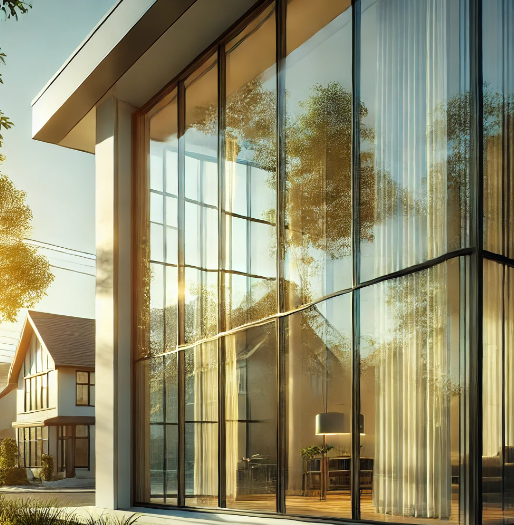![]()
In the current world of evolving architecture, glass glazing has become a component that not only enhances the aesthetics of a building but also adds to energy efficiency, noise reduction, and safety. As more cities across India, including Kolkata, Bhubaneswar, Ranchi, and Guwahati, embrace contemporary architectural designs, the demand for advanced glazing technologies will grow.
In this beginner level guide, we look at the technical aspects of glass glazing, its importance, types, benefits, and essential maintenance criteria. Whether you’re building a new residence or upgrading your windows, understanding the intricacies of window glazing will help you make an informed choice that not only enhances your space’s beauty, but also adds to its comfort, and functionality.
Introduction to Glass Glazing
Glass glazing refers to the process of sealing glass to window frames and other structural components. It involves the application of various layers of glass to control temperature, sound, and light, making it a critical component in both residential and commercial buildings. Over the years, glazing has evolved from simple single-pane to sophisticated multi-pane systems that offer a large range of benefits.
But do you know what is glazing on a window, and why is it essential in modern architecture?
What is Glazing on a Window?
Glazing refers to the attachment of glass in a frame or the glass itself thereby improving thermal insulation, reducing noise, controlling UV rays, and improving security. The kind of window glazing can have a significant impact on the energy efficiency of a building, making it important for homeowners and architects.
Types of Glass Glazing
Choosing the correct type of glazing for your windows depends on your needs, location, and budget. Here are some of the common types of glazing used in homes and commercial properties across Eastern Indian cities:
- Single-Glass Glazing: This is a basic type of glazing, where a single sheet of glass is installed. Although it provides a clear view and some protection from the atmospheric elements, it lacks the insulation and soundproofing capabilities of more advanced glazing types.
- Double-Pane Glazing: This is a relatively more energy-efficient option where two glass panes are separated by a gap filled with air or gas. Double glazing helps reduce heat loss and noise, making it good option for cities like Kolkata and Bhubaneswar, where temperature fluctuations and noise pollution are quite common.
- Triple-Pane Glazing: For better insulation and soundproofing, triple-pane glazing is the right option. The additional pane adds another layer of protection against temperatures and noise, making it useful for buildings in industrial or high-traffic belts.
Reglazing Single-Pane Windows
If you stay in an older home with single-pane windows, you might be interested in reglazing to improve insulation and security. Reglazing involves removing the old glass and replacing it with new, more efficient glass while keeping the original frame intact. This is a cheap way to improve your windows without the need for a complete overhaul.
Reglazing Double-Pane Windows
Reglazing double-glass windows is complicated than single-glass reglazing, as then you have to apply multiple layers of glass and insulating gases. However, due to the benefits of energy savings and comfort it can be a good investment, especially in cities like Ranchi and Patna, where winters can be chilly, and summers are hot and humid.
Glazed Glass Windows: Types and Benefits
There are several types of glazed glass windows available, each offering nice benefits:
- Tempered Glazing: Great for its strength and safety, tempered glass is good for areas with high winds or storms.
- Laminated Glazing: This type of glass holds together when shattered, making it great for areas where safety and security are important.
- Insulated Glazing: Generally used in double- and triple-pane windows, insulated glazing helps maintain a constant indoor temperature by reducing heat transfer.
Advantages of Modern Glazing Technologies
Modern glazing technologies have brought about improvements in window performance like:
- Energy Efficiency: By reducing heat transfer, glazing can lower heating and cooling costs by up to 30%.
- Acoustic Insulation: Reduces noise pollution, making your home or office a quieter and more comfortable place.
- UV Protection: Specialized coatings can block harmful UV rays, protecting your furniture and interiors from fading.
- Enhanced Security: Laminated and tempered glass are difficult to break, providing an added layer of security.
How to Choose the Right Glazing for Your Windows
When choosing the right glazing for your windows, consider the following factors:
- Climate: In hot and humid climates like Kolkata, double-pane windows with low-E coatings are ideal for keeping your home cool.
- Noise Levels: If you live in a noisy area, triple-pane windows can significantly reduce outside noise.
- Budget: While multi-pane windows are more expensive , they offer long-term lower cost through reduced energy costs.
- Aesthetic: Choose a glazing style that looks nice on your home’s architectural design.
Maintenance Tips for Glazed Glass Windows
Good maintenance is important to ensure the longer tenure and performance of your glazed windows. Here are some tips:
- Clean Regularly: Use a soft cloth and non-abrasive cleaner to keep the glass looking shiny as new.
- Inspect for Leaks: Periodically check the seals around your windows for any signs of wear or tear.
- Repair Cracks Immediately: Even small cracks can lead to significant heat loss or safety issues, so address any damage timely.
Sample Calculation: Energy Savings through Double-Pane Glazing
Scenario:
A house in Bhubaneswar has 8 single-pane windows with an area of 2m² each. The energy loss per window is 180 kWh/year. After upgrading to double-pane windows, the energy loss per window reduces to 90 kWh/year.
- Energy loss before the upgrade:
8 windows × 180 kWh/year = 1440 kWh/year - Energy loss after the upgrade:
8 windows × 90 kWh/year = 720 kWh/year - Total energy savings:
1440 kWh/year − 720 kWh/year = 720 kWh/year
At an electricity cost of ₹6 per kWh, the homeowner would save:
720 kWh/year × ₹6/kWh = ₹4320/year
The homeowner would save ₹4320 annually by upgrading to double-pane windows.

Leave a Reply